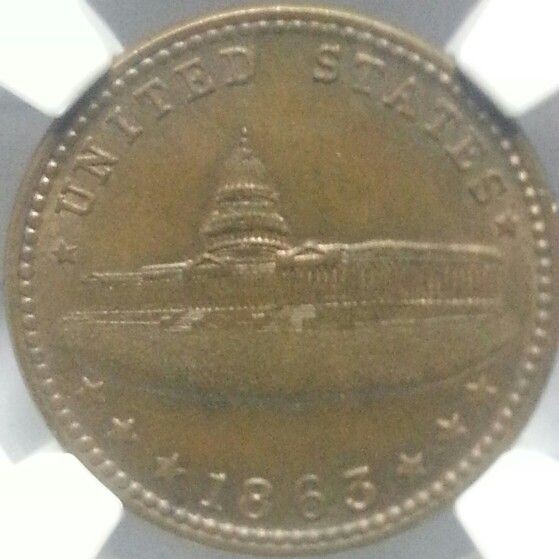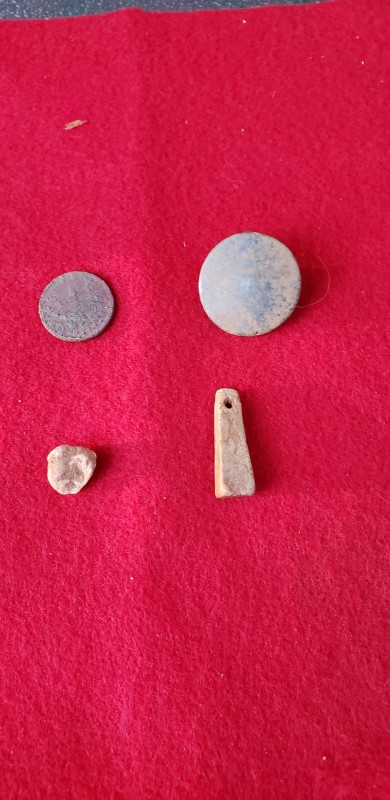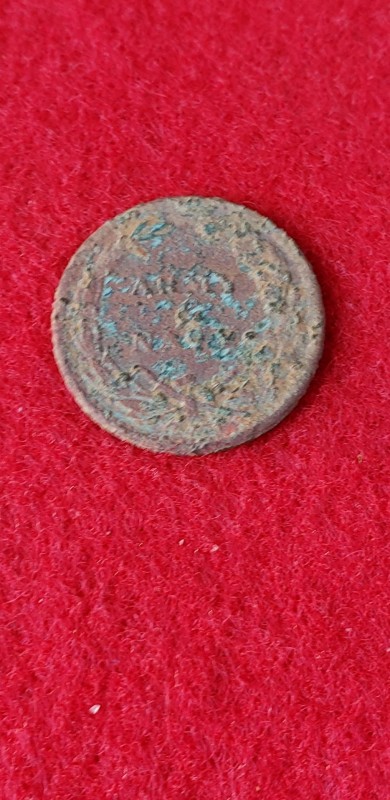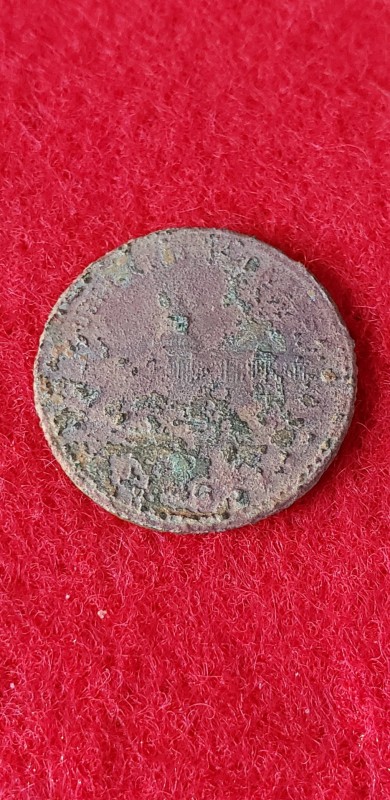-
Posts
6,131 -
Joined
-
Last visited
Content Type
Forums
Detector Prospector Home
Detector Database
Downloads
Everything posted by Chase Goldman
-

Detecting With The Vanquish 340
Chase Goldman replied to palzynski's topic in Metal Detecting For Coins & Relics
That's why there are 3 models. -

Some Cw Relic Keepers
Chase Goldman replied to Chase Goldman's topic in Metal Detecting For Coins & Relics
Also try etsy and civil war relic auction sites. Good luck. -
The answer to your "is there any advantage" question is yes, provided you understand what 20 and 40 khz individual frequencies bring to the table. Since you are asking the question, I take it that is not fully understood by you as a newcomer to the hobby and to the understanding of how metal detectors work, so let me explain how detector operating frequency affects your ability to detect targets. First let me say that what I am about to tell you is applicable in general terms. It is more of a guideline rather than set in stone because metal detectors are actually relatively crude tools that can only infer what the target is underneath the coil using relatively crude induction balance techniques and signal processing. The detected behavior of the high frequency magnetic field induced in the target by the "transmit" coil is picked up by the "receive" coil and now typically run through software based signal processing provide a best guess as to what the target is - frankly it is amazing to me how well detectors can actually ID targets based on what physical parameters they are actually detecting.. The detected behavior is influenced by the strength of the magnetic field transmitted into the ground, the frequency of the magnetic field, and the characteristics of the ground, and characteristics of the target itself. All of these aspects have multiple variations that affect how the detector "see" the target. Without going into all of that, there two main physical aspects of detector frequency that are important to the detectorist. First, magnetic field strength depth penetration into the ground. Higher frequency signals like 20 and 40 khz tend get attenuated more than the lower operating frequencies like 5 and 10Khz. This means, in general, the ultimate depth of detectable targets is less when you are using higher frequencies than lower frequencies. The affect can be subtle from a few centimeters to several centimeters depending on soil conditions and the targets of interest. The second thing to know about frequency is that it tends to provide a stronger receive signal for targets that are small in physical size/mass and/or that have a lower overall specific conductivity. This makes these higher frequencies more suited to finding small targets like jewelry and/or smaller targets comprised of lower conductivity metals like natural gold, gold jewelry, lead, brass, aluminum. These targets will tend sound off better at higher frequencies than lower frequencies. Larger and/or high conductive targets like silver coins are detected at depth better with lower frequency signals. Again, these are relative effects, not absolute and subject to all the environmental variables and physical variables that make metal detecting a challenge. Another advantage to have additional individual frequencies to choose from is that it gives you more flexibility to choose and operating frequency that may not be subject to local electromagnetic interference from nearby sources of noise such as power lines and cellular telephone towers, wifi transmitters, etc. Anecdotally, higher operating frequencies also tend to be more immune from the more common sources of electromagnetic interference, at least in the USA. That all being said, I usually detect in Multi IQ (multi frequency mode) most of the time because of the advantages multi has over single frequency operation, but it is nice to know I can go to single frequency on those occasions when needed, and in the case of the 800 nice to have the additional single frequency choices. Bottom line, versatility and options are generally good things to have at your disposal when metal detecting because you seldom encounter perfect conditions, but it is also rare that you have to invoke these options on every outing. Will an Equinox 600 suit the needs of 95% of detectorists 95% of the time - I would say yes. Can you find natural gold with the Equinox 600 even though it does not have a gold mode? Yes. The question you need to ask yourself is whether the Equinox 800 is worth the price difference to you. Your stated goal was to seek natural gold and coin shooting. Those are two very different types of metal detecting with different sites, strategies, and approaches. Which favors you getting a versatile detector. The 600 is pretty versatile, but the 800, even more so with Gold mode, a user profile slot, a larger range and more precise control of detector recovery speed and the iron bias filtering, and more flexibility when it comes to setting up the target tones features. You simply need to answer for yourself whether you will have regret because you don't have these additional features if you choose the 600 or be happy you saved some money. As someone new to the hobby, that is hard to answer. If you can afford the 800, then I suggest you get it. If you are not even sure if the hobby is something you will really want to stick with, I would suggest getting a capable entry level machine such as the Minelab Vanquish, 440 or 540 which has pretty good performance at a lower cost and investment risk. HTH
-

Some Cw Relic Keepers
Chase Goldman replied to Chase Goldman's topic in Metal Detecting For Coins & Relics
Yes there are several varieties of Patriotic tokens in general and at least three different "Army & Navy" token varieties that I am aware of. They were also used as penny coins when people started hoarding legitimate legal coinage during the war. -
To this point, I wish that ML had provided the option to select the gold mode modulated audio as an option on the other modes and had provided the option to select tone ID audio with the gold modes. My solution is to just switch between gold mode and the preferred non-gold search mode profile suitable for the my target objectives and site conditions, as necessary, using the user profile slot. The ability to quickly switch to the user profile slot is an underappreciated bonus feature of the 800 (though I wish the button resided on the face of the control panel) as well as the common misunderstanding that gold mode is primarily only useful for prospecting.
-

Some Cw Relic Keepers
Chase Goldman replied to Chase Goldman's topic in Metal Detecting For Coins & Relics
I see it was recovered in great shape, not exposed to the 157 years of farm field fertilizer and soil corrosive effects mine experienced. Attached is what a pristine version of my token would look like. -

Some Cw Relic Keepers
Chase Goldman replied to Chase Goldman's topic in Metal Detecting For Coins & Relics
This is not about money (frankly I wouldn't even know how to price it) it is about the find, what it took to recover it and the historical context of the item itself and where I found it, especially if it a unique "personal" item like that fashioned by some soldier on a battlefield/campsite or a native American's kettle point. Those all outweigh any financial considerations and is the same logic I use in reverse and is the reason I also seldom purchase relics. The historical context may be partially there, but the lack of an interesting story about how it came to be in my possession makes a bought artifact less attractive to me. In other words, it is less about what the object is, but the complete picture of how it found its way into the ground and back out and in my hands. It serves as a permanent record of the experience and I enjoy looking back on that experience in my displays just as someone likes to pour through their photograph album. Just the way I roll. It is also why I am a million miles away from the "detector has paid for itself" mind set. I don't mind finding gold and silver jewelry and modern coins, but I get a lot more satisfaction from finding items of historic value versus intrinsic value. I have never detected for natural gold, however. There I would likely be conflicted between cashing it in for its intrinsic value and admiring its natural beauty. Naw...I would cash it in. -

Some Cw Relic Keepers
Chase Goldman replied to Chase Goldman's topic in Metal Detecting For Coins & Relics
Sorry, TH. Thanks for the offer but I do not sell my relic finds. -
Managed a couple keepers at a new site last week including an 1863 CW Patriotic token with "Army and Navy" on one side and an engraving of the Capitol building on the reverse. A little crusty but I'll take it. A fishing weight carved from a lead minie ball, another lead fragment, and a large flat button. Enjoyed the hunt though it was a balmy 95F out there. Snagged the token and lead with my GPX and the flat button with my Deus. Cheers.
-
The only thing I caution since you water sealed it up so tight is to avoid using it in direct sun and high temps on the beach out of the water. I think you might suffer some overtemperature effects under those conditions. Since you are detecting in the water for the most part should not be a problem. Also, rinse out that Nox headphone jack with fresh water after each use, even though you will probably not get a lot of water intrusion with you setup, any salt water whatsoever in that jack will eventually corrode the metallic h/p jack components. Good luck looks like you are well on your way to cleaning up on your local beaches. Hopefully tourism will pick up again to refresh your beaches.
-
Believe me, I have acquired enough spare components (headphones, coils) for two Deus Setups because the headphones and remote are separable and got the ORX remote and headphones used and just paired them with my 3 existing Deus coils so I guess I could have up to 3 separate setups counting Orx, so it can get confusing. It is easy to swap the coils because they have serial numbers but the pinpointers don't have separate numbers you can manually select plus the "lost pinpointer" beacon can also throw things off. Good luck and hopefully it doesn't happen again.
-
You probably should avoid swapping components between the two setups (especially the pinpointers) as you may be "confusing" the control module (perhaps the other pinpointer was not completely unpaired from the module or glitched during the unpairing process, who knows - but it just sounds like a recipe for confusion). Kind of a first world problem for those of us who can afford two or more complete ORX setups, I suppose. Anyway, there is no email but the contact address and phone number are: Detector Electronics Corp.23 Turnpike RoadSouthboro, MA 01772508-460-6244 The support web page is: https://www.xpmetaldetectorsamericas.com/xp-service-and-repairs Or if you misplace this bookmark just google XP Americas...not so hard. Happy 4th Relicmeister.
-
Agree! That was how I was understanding it myself. The key is depth is not reduced (not a step backwards as Monte put it) with the latest software because you will still get target audio, just no visual target ID and random chatter and you retain all the other improvements that came along with 2.77 (headphone audio, new "Park 1" mode, AM threshold/ground adjust, etc. Don't have an Impact, but your theory sounds plausible based on how Nokta implemented that hidden setting in Impact. They are simply limited by the firmware/hardware interface implementation in Simplex and have to do it less "gracefully".
-

Transmitter For A Wm08 ( Nox Wifi Receiver) For A 2300
Chase Goldman replied to PeterInSa's topic in Minelab Metal Detectors
He answered your question. The Wi-Stream wireless protocol used to communicate between EQX and the WM08 is Minelab proprietatary and nether Minelab nor any third parties have offered a standalone transmitter compatible with the WM08. Only the transmitters bulit into the EQX are compatible. Same is true for the wireless Wi Stream receiver modules used for the CTX (WM10) and GPZ, no cross model compatibility (another non-sensical, frustrating business decision by ML). Even the standalone Pro Sonic Wi Stream Receiver/Transmitter kit is only compatible with its own receiver/transmitter hardware even though all of the above wireless products use the Wi Stream protocol. -
Gotcha! Otherwise, I thought that was a pretty cheeky move.
-
So you are keeping the new Equinox setting a secret?
-

Advice On Getting Permission
Chase Goldman replied to TreasureHunter5's topic in Metal Detecting For Coins & Relics
If you are going to dig on a nice lawn or yard I would suggest the following: First, after acquiring a target, see if it is shallow enough to be picked up by your pinpointer on the surface. If so, you might be able to use a probe or screwdriver to locate and flip out the coin target without taking a plug. If you are going to take a plug, the best way to prevent a brown grass situation is to cut a flap so that at least a part of the turf root structure is intact on the flap, fold it back, then remove the dirt as usual. placing it on your t-shirt or other cloth/towel for easy restoration after you have retrieved the target. Cutting a completely round plug on a lawn (especially a well manicured lawn) will result in a visible mark after a day or so, cutting a flap instead reduces the chance o that happening and will make your host happier. Practice that in your yard or at a public park where you don't have to seek permission. Then you can honestly tell them you have a method of recovering targets from the ground where you will leave no trace. As far as gaining permission - First dress for success>ask permission without being fully decked out in your dirty MD clothes, pouch kneepads, digger, etc. Wear casual but clean clothes and don't put the property owner on the spot (if it is a neighbor) that you want to dig now. Converse about the house, nice property, and then gradually bring up the metal detecting piece, how you find it interesting, and have found interesting history type stuff in your yard. Then ease into asking if they would mind if could search their yard for similar stuff. Ask if they would like to see what you found to see if it might have some meaning or value to them as property owners. Ask them if they have lost anything in their yard that you could find for them.. Don't emphasize jewelry or coins, just talk about interesting trinkets like buttons and lost toys. Ask if they want to see your finds and tell them that you will remove any trash or dangerous sharp items (can shards, nails) that you come across. Be friendly, respectful, and show more of an interest in them than their property and you will get more yes's than no's. If you have something from your kitchen or yard (cookies, apples, tomatoes) that you want to share you can bring those along as a conversation starter. The approach is a little different if you are seeking permission in a more remote area from your house. In that case you can talk about the area (do some history research) - For example, "Did you know an old house stood near your property?" Of "Did you know a civil war unit camped nearby?". And then say, I do research and on historical events and like to collect artifacts using a detector if I can gain access to a property. Again, stay away from talks of treasure - emphasize historical significance of what might otherwise be considered metallic junk (discarded buttons, thimbles, tools, knapsack parts) but that it interests you nonetheless because you understand its historic significance. Offer to show your finds, etc. Be prepared to offer something neat in return for gaining their permission, such as a cool button or coin your found. It is their property and they can dictate the terms of your access. Good luck. -

Detecting With The Vanquish 340
Chase Goldman replied to palzynski's topic in Metal Detecting For Coins & Relics
Good but not necessarily news in the sense that they are both the same detector under the hood just lack of a few features and only one pseudo performance based setting (iron bias level) and lack of relic and pinpoint modes (which you failed to mention but which I think would be a useful feature for the target demographic - beginning detectorists), so I am not surprised in the least by your findings. Depth and TID accuracy/repeatability should be identical. News would have been if you found a significant performance difference. Not a criticism at all, by the way. I am glad you took the time to verify the expected results. Very nice finds, BTW. Just goes to show that bells and whistles wow people and sell machines, but machines stripped down to minimalist essential features can be just as capable and fun under the right circumstances. Great value for the occasional detectorist. Depth obsessed detectorists need to realize that basically all modern, main stream vlf IB detectors have about the same relative depth capability - it really comes down to coil selection, target type, site conditions, and operator proficiency as the factors that make a difference. You don't have to pay a lot for adequate depth and reliable ID capability, the two basic must haves for any detector. There is something about challenging your skills with a less complex detector that makes the hunt a little more exciting (provided you DO find keepers) plus the turn it on and hunt simplicity is kind of liberating when you are not compelled to tweak your machine to the gnat's eyelash because you can't. I felt good about my essentially equivalent success using the ORX compared to the Deus at one of my favorite sites. Just turned it on, hunted, recovered target and moved on. No 30 to 60 second interrogations in multiple modes etc. I compare that with amateur radio operators who challenge themselves in trying to maximize distant radio contacts using as little transmit power as possible. The smaller, less powerful radio and minimalist antenna are portable so they seek out mountain tops and try to make distant contacts. Something like the Vanquish that is light, compact, and relatively cheap can be kept permanently in your vehicle so you can always have something to swing should the opportunity arise. PS - I remain confused regarding the depth and recovery level difference between the three primary 540 modes (jewelry, relic, and coin), so not sure whether lack of relic mode on the 340 presents a slight performance issue in comparison to the 540 What is your preferred mode selection on the type of hunt you documented above (I presume Jewelry mode based on the pic, but wanted to verify)? -

Wireless Transmitter For Impulse
Chase Goldman replied to Tmox's topic in First Texas - Bounty Hunter, Fisher & Teknetics
Got it. I don't have one in front of me, just see all that stuff poking out of the back of the rear pod and it is hard to grasp the scale, it looks thicker than 8 mm which is just 1 mm more than a standard 3.5 mm plug assembly (the cable itself probably being 4 to 6 mm). That IS dainty and I now remember your comment about the cables being more supple and less rigid flex than expected. I should have remembered your broken power cable saga. I just have the Garrett waterproof headphone jack/plug stuck in my head and thick stuff like that used on the Excal. Anyway, looking forward to seeing your BT setup configuration. Thanks. -

Wireless Transmitter For Impulse
Chase Goldman replied to Tmox's topic in First Texas - Bounty Hunter, Fisher & Teknetics
Yeah, "practical" wasn't the right term, as it is certainly doable. What I was driving at was that the configuration of the rear section of the detector and associated thick jumper would make the solution using a trond-like dongle a kludgy proposition and not very secure/robust because it would be hard to tuck away and protect like what I do when I use the Trond with my GPX - but I suppose anyone who is determined can make anything work as Rivers Rat contraption shows, function over form. What I was primarily driving at (and as I discussed in my subsequent exchange with Alexandre) was that wireless is a desirable feature even in a water detector and I see no harm in asking the designers to figure out a way to overcome any obstacles (e.g., EMI) to integrate wireless audio directly into even an "AQ" detector as a future standard feature rather than having users have to figure out how to jury rig it. Would be interested in details and parts once you fabricate your BT solution for the AQ, so please post them if able. Thanks, Steve. Yeah, why do you think that is? Perhaps people get confused because of the "AQ" in the detector's name and the fact that it IS waterproof. Seriously though, I personally don't automatically think anything when it comes to detector usage. I know people find ways to use detectors well beyond their intended design envelope. I try to look at all the possible ways I might want to use a detector in a manner not envisioned by the designer. Versatility is key. Not sure if your comment was directed at me or not, but In the case of the AQ, I was only talking about not exposing the third-party Trond module to the elements IF one decided to take the Impulse "AQ"into the water since the AQ is marketed and designed for submerged wading as well as wet beach use - that doesn't presume it would ONLY be used in the water or even EVER be used in the water by anyone who purchases an AQ. Furthermore, that was why I was advocating integrating BT or wireless audio into the detector itself, so the need for an external module would be unnecessary. If I automatically assumed EVERYONE would be using the AQ for [submerged] water hunting, I wouldn't even bother making that suggestion as wireless doesn't work when submerged. If I do get an AQ or a future iteration, like you, most of my detecting will be in wet sand or a couple feet of water at most due to the physical limitations brought on by being on this planet for so long. Guess the jury is still out on AQ - we'll have to see if third party coils and headphones with the requisite non-standard connectors start showing up from third parties so you can at least get two out of three. But yeah, at least they are not hard-wired like the Excal. -

Wireless Transmitter For Impulse
Chase Goldman replied to Tmox's topic in First Texas - Bounty Hunter, Fisher & Teknetics
Alexandre - Would having a third party external transceiver in close proximity to the headphone port be an EMI concern or is it sufficiently isolated and distant from the control electronics to be a non issue? If that is not an issue, could a transmitter be placed internal to the aft power/audio module, isolated from the control electronics, and fed analog audio directly to provide that wireless feature in a future iteration of the design (a simple switch could reroute the audio between the transmitter and the headphone port)? Another advantage of that placement would be that it would be less likely to be submerged during wading detecting because it would be at the highest point on the detector as opposed to the control panel thus maintaining line of site transmission. If a 3rd party transmitter “dongle” setup is not subject to causing interference, would like to see anyone’s practical implementation. I’m just not visualizing a practical implementation/approach for that setup even if you take the EMI issue out of the equation. -

Wireless Transmitter For Impulse
Chase Goldman replied to Tmox's topic in First Texas - Bounty Hunter, Fisher & Teknetics
I don’t see how these micro BT transceivers are even practical for use on Impulse given the special connector for the audio output. The connector alone must weigh more than than twice the Trond module and that is not even accounting for the weight of the patch cable that you would have to custom fabricate yourself. Besides the module can’t really can’t be exposed to moisture. For something like this, it would have been preferable for the transmitter to be built into the detector (a la Equinox, Vanquish, Simplex, or Apex). -
It's not new. It is the website front end they use for aftermarket Tek and Fisher detector hardware and firmware upgrades. Got my T2 modded to DST using this web interface. Stumble across it is right - you have to be fed the link when they solicit you for the upgrades via the email you used for registration. It's not really meant to be a store front. I mean how generic can you get "detecting.com" indeed.
-

Whites V3i Vs The XP Deus
Chase Goldman replied to RobNC's topic in Metal Detector Advice & Comparisons
Rob - I actually got the MXT AFTER the Deus once I saw what it could do in the hands of an expert in highly mineralized dirt. I at first got an MX Sport, mistakenly thinking Whites had put the MXT DNA into the Sport chassis. Wrong. Got an MXT with an Ultimate 13" coil and started getting some proficiency, then the Equinox came along and that was that. Not letting the MXT go though and will still bring it out for some swing time. Glad you re-obtained the Orx - keep your eyes pealed for someone trying to unload a Deus control unit and phones for cheap. You already have a compatible coil, you might luck into a good Deus deal that way. GL HH






